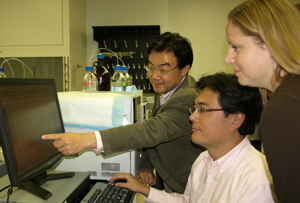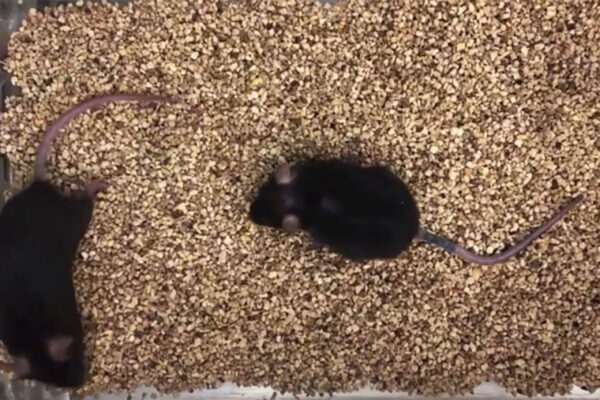 Researchers (from left) Shin-ichiro Imai, MD, PhD, Jun Yoshino, MD, PhD, and Kathryn Mills showed that a natural compound, NMN, helps to treat symptoms of diabetes in mice. Julia Evangelou Strait
Researchers (from left) Shin-ichiro Imai, MD, PhD, Jun Yoshino, MD, PhD, and Kathryn Mills showed that a natural compound, NMN, helps to treat symptoms of diabetes in mice. Julia Evangelou Strait
Researchers at Washington University School of Medicine in St. Louis have restored normal blood sugar metabolism in diabetic mice using a compound the body makes naturally. The finding suggests that it may one day be possible for people to take the compound much like a daily vitamin as a way to treat or even prevent type 2 diabetes.
This naturally occurring compound is called nicotinamide mononucleotide, or NMN, and it plays a vital role in how cells use energy.
“After giving NMN, glucose tolerance goes completely back to normal in female diabetic mice,” says Shin-ichiro Imai, MD, PhD, associate professor of developmental biology. “In males, we see a milder effect compared to females, but we still see an effect. These are really remarkable results. NMN improves diabetic symptoms, at least in mice.”
The research appears online Oct. 4 in Cell Metabolism.
Imai says this discovery holds promise for people because the mechanisms that NMN influences are largely the same in mice and humans.
“But whether this mechanism is equally compromised in human patients with type 2 diabetes is something we have to check,” Imai says. “We have plans to do this in the very near future.”
All cells in the body make NMN in a chain of reactions leading to production of NAD, a vital molecule that harvests energy from nutrients and puts it into a form cells can use. Among other things, NAD activates a protein called SIRT1 that has been shown to promote healthy metabolism throughout the body, from the pancreas to the liver to muscle and fat tissue.
According to the study, aging and eating a high-fat diet reduce production of NMN, slowing the body’s production of NAD and leading to abnormal metabolic conditions such as diabetes. NAD cannot be given to the mice directly because of toxic effects. But after administering NMN, levels of NAD rise and the diabetic mice show dramatically improved responses to glucose. In some cases, they return to normal.
“I’m very excited to see these results because the effect of NMN is much bigger than other known compounds or chemicals,” says first author Jun Yoshino, MD, PhD, postdoctoral research associate. “Plus, the fact that the body naturally makes NMN is promising for translating these findings into humans.”
Imai and his colleagues found that young, healthy mice on a high-fat diet developed diabetes in six months or less. In these mice, they found that NAD levels were reduced. But after administering NMN, levels of NAD increased and the female mice had normal results in glucose tolerance tests — a measure of how well the body moves glucose from the blood to the organs and tissues for use. Glucose tolerance was also improved after male diabetic mice received NMN but did not quite return to normal. The researchers are interested in learning more about these differences between male and female mice.
“We don’t have a clear answer, but we are speculating that sex hormones, such as estrogen, may be important downstream for NAD synthesis,” Yoshino says.
In older mice, they observed that about 15 percent of healthy males fed a normal diet developed diabetes.
“When we injected these older diabetic mice with NMN, they had improved glucose tolerance, even after one injection,” says Kathryn F. Mills, research lab supervisor and an equally contributing first author of the study. “We also injected older healthy mice and found that they weren’t adversely affected. It’s good to know that even if the mice are not diabetic, giving NMN is not going to hurt them.”
Imai says few studies have examined normal mice that naturally develop diabetes as a simple result of aging because the experiments take so long. In an interesting twist, few elderly female mice developed diabetes at all. But after switching to a high fat diet, older female mice quickly developed severe diabetes.
“Again, when we injected these females with NMN, we came up with a completely normal glucose tolerance curve,” Mills says. “We can also see that the NMN has completely reversed and normalized the levels of cholesterol, triglycerides and free fatty acids.”
Though the mice received NMN by injection in this study, Imai’s group is now conducting a long-term study of diabetic mice that get NMN dissolved in their drinking water. Imai calls this work a first step toward a possible “nutriceutical” that people could take almost like a vitamin to treat or even prevent type 2 diabetes.
“Once we can get a grade of NMN that humans can take, we would really like to launch a pilot human study,” Imai says.
Yoshino J, Mills KF, Yoon MJ, Imai SI. Nicotinamide mononucleotide, a key NAD+ intermediate, treats the pathophysiology of diet- and age-induced diabetes in mice. Cell Metabolism. Online Oct. 4, 2011.
This work was supported in part by the National Institute on Aging, the Ellison Medical Foundation, the Longer Life Foundation, the Washington University Nutrition Obesity Research Center, the Washington University Diabetes Research and Training Center. Jun Yoshino is supported by the Japan Research Foundation for Clinical Pharmacology, the Manpei Suzuki Diabetes Foundation, and the Kanae Foundation for the Promotion of Medical Science.
Washington University School of Medicine’s 2,100 employed and volunteer faculty physicians also are the medical staff of Barnes-Jewish and St. Louis Children’s hospitals. The School of Medicine is one of the leading medical research, teaching and patient care institutions in the nation, currently ranked fourth in the nation by U.S. News & World Report. Through its affiliations with Barnes-Jewish and St. Louis Children’s hospitals, the School of Medicine is linked to BJC HealthCare.


